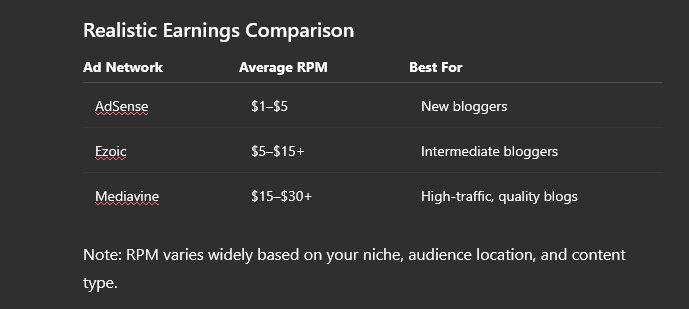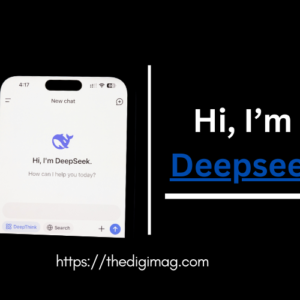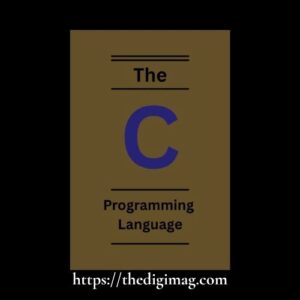If you are a blogger who wants to monetize your content with an ad network, there are three popular names: Google AdSense, Ezoic, and Mediavine.
Each offers different tools, ad types, and earning potentials depending on your traffic and goals. In this guide, we’ll break down how these networks work, what types of ads they offer, and which one is best suited for your blog.
What Are Display Ad Networks?
Display ad networks connect advertisers with website owners. When you join a network, it serves ads on your blog and pays you based on impressions (RPM) or clicks (CPC). The more traffic you have and the better your user engagement, the more you can earn. Choosing the right ad network can make a big difference in your blog’s income and user experience.
1. Google AdSense

AdSense is Google’s own ad network, and it’s often the first stop for new bloggers. It’s easy to set up and doesn’t require a minimum traffic threshold.
Types of Ads Offered:
- Display ads (image or interactive media)
- Text ads (simple clickable text)
- In-feed ads (embedded within post lists or category pages)
- In-article ads (auto-placed between paragraphs)
- Auto ads (Google’s AI places and optimizes ads for you)
Pros:
- Very easy to get started
- Auto ads simplify ad placement
- Best suited for low-traffic sites
Cons:
- Low earning potential (RPM usually around $1–$5)
- Limited customization options in AdSense
- At times, ads may seem generic or irrelevant to the content.Ads can appear generic or irrelevant
Best For: Beginners with small blogs or hobby sites
Side Note: Google offers two separate services with similar names but very different purposes:
- ads.google.com: This is for advertisers who want to run paid ad campaigns through Google Ads.
- google.com/adsense: This is for publishers (like bloggers and website owners) who want to earn money by displaying ads on their sites.
If you’re a blogger looking to monetize your website, you’ll want to use Google AdSense at https://www.google.com/adsense.
2. Ezoic

Ezoic is a Google Certified Publishing Partner that uses AI to optimize ad placements, which improves both earnings and user experience. As of 2025, Ezoic requires a minimum of 10,000 monthly visits (though some sites can use their Access Now program with lower traffic).
Types of Ads Offered:
- All AdSense ad types
- Floating/sticky ads
- Video ads
- Interstitial ads (shown between page views)
- Native ads (See the bottom of the article for supplementary details)
Pros:
- Higher RPM than AdSense (typically $5–$15+)
- Full control over layout and ad placement
- Integrated site speed tools and analytics
Cons:
- Slight learning curve during setup
- Site speed can drop if not optimized properly
Best For: Bloggers with at least 10,000 monthly visits aiming to increase ad revenue without joining premium networks yet
3. Mediavine

Mediavine is considered one of the top-tier ad management companies for content creators. Known for high RPMs and strict site quality standards, it requires 50,000 monthly sessions to apply.
Types of Ads Offered:
- High-quality display ads
- Sticky sidebar and in-content ads
- Video ads
- Sponsored content integration
- Custom placements tailored to UX
Pros:
- Excellent RPMs ($15–$30+ depending on niche)
- Dedicated support and optimization team
- Mobile-friendly and fast-loading ads
Cons:
- High entry barrier (50K sessions/month)
- Slower approval process
Best For: Established blogs with significant traffic that want to maximize revenue with high-quality ad experiences

Which One Should You Choose?
If you’re just starting out, AdSense is a quick and easy way to test the waters of ad monetization.
If you’ve grown your blog to 10K+ visits, Ezoic can significantly boost your earnings with smarter ad placement and analytics.
If you’ve reached 50K+ monthly sessions, Mediavine is arguably the best in terms of income, support, and user experience.
Bonus Tips:
- Focus on content quality and traffic first—ads will perform better with more engaged readers.
- Test ad placements regularly to avoid disrupting user experience.
- Always comply with ad policies to avoid suspension from any network.
Conclusion: Monetizing your blog through ads can be highly rewarding, but choosing the right network at the right stage of your growth is key. Start with AdSense, move to Ezoic when ready, and aim for Mediavine as your traffic scales up. With the right strategy, your blog can become a reliable source of passive income.
Supplementary Information:
What Are Native Ads?
Native ads are a type of paid advertisement that blend seamlessly into the design, format, and flow of the content where they appear. They match the look and feel of the platform, making them appear less like traditional ads and more like part of the editorial content.
Key Features of Native Ads:
- Non-intrusive: They don’t disrupt the user experience like pop-ups or banner ads.
- Content-based: Often appear as recommended articles, sponsored stories, or promoted posts.
- Platform-matching: Styled to look like normal content on the website or app.
Examples of Native Ads:
| Platform | Native Ad Example |
|---|---|
| News Websites | “Sponsored Content” articles that resemble news posts |
| Facebook / Instagram | “Sponsored Posts” that look like regular updates |
| YouTube | Video ads that appear in the suggested video feed |
| Blogs | Product reviews or affiliate articles labeled “sponsored” |
Suggested Reading:




